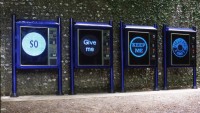ROSE FINN-KELSEY
It Pays to Pray
source: sculptureorguk
Here are chocolate vending machines, the like of which are used every day by hungry commuters moving about cities all over the world. But how strange they are when placed deep in the Sussex woodland. Linking diametrically opposed concepts and placing things in unlikely contexts are familiar themes in Rose Finn-Kelsey’s art, and ‘It Pays to Pray’ represents yet another unexpected coupling. The idea of indulging our craving for comfort with chocolate but receiving instead a prayer, gives us pause for thought. Across cultures, sometimes prayers are freely given but also sold. Bounty, Starbar, Flyte, Delight, Wispa, Drifter, Timeout, Picnic, Ripple, Devour – all names of chocolate bars – are taken as titles for the prayers, thereby turning them into sustaining concepts.
The non-denominational prayers in ‘It Pays to Pray’ were originally written by Finn-Kelsey on a blackboard: some one hundred and fifty in total, just ten being chosen for this sculpture. They emulate the free form of speech, and as Andrea Schlieker has written, ‘Akin to poems, aphorisms, invocations or song lyrics, they are made up of short, succinct sentences. Their mood ranges from happiness to neurosis, from childishness to the elegiac, like inner voices or confessions.’ On payment, the prayers are delivered digitally by the machine’s Light Emitting Diode (LED), the twenty pence coin is then returned to the purchaser, clattering into its receptacle.
The work was enabled by the Cass Sculpture Foundation for the Millennium Dome’s North Meadow site, and this being within the public domain, Finn-Kelsey was obliged by the Dome’s administration to justify the piece to the Bishop of Lambeth’s deputy. Our understanding of the parallel between the instantaneous physical – even psychological – uplifting effect of chocolate, and that sought in prayer, is given full three dimensional presence in the proposition that ‘It Pays to Pray’.


